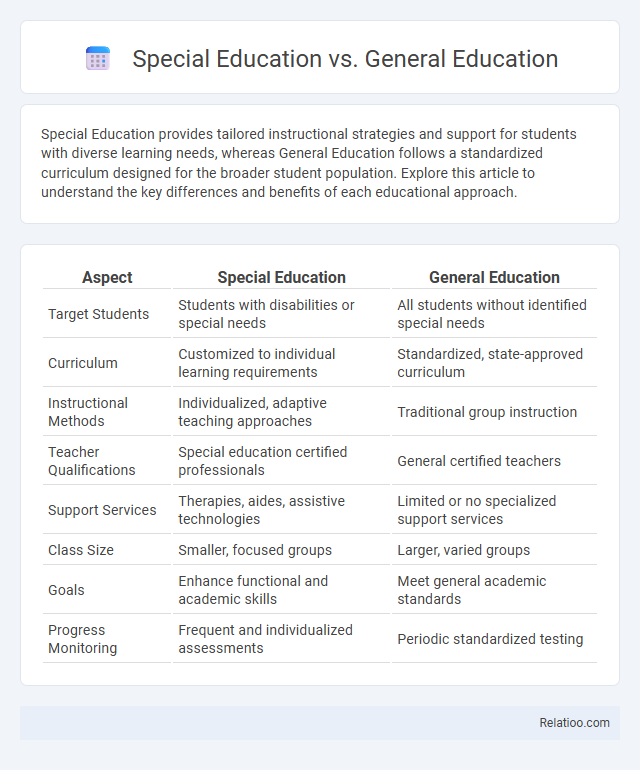Special Education provides tailored instructional strategies and support for students with diverse learning needs, whereas General Education follows a standardized curriculum designed for the broader student population. Explore this article to understand the key differences and benefits of each educational approach.
Table of Comparison
| Aspect | Special Education | General Education |
|---|---|---|
| Target Students | Students with disabilities or special needs | All students without identified special needs |
| Curriculum | Customized to individual learning requirements | Standardized, state-approved curriculum |
| Instructional Methods | Individualized, adaptive teaching approaches | Traditional group instruction |
| Teacher Qualifications | Special education certified professionals | General certified teachers |
| Support Services | Therapies, aides, assistive technologies | Limited or no specialized support services |
| Class Size | Smaller, focused groups | Larger, varied groups |
| Goals | Enhance functional and academic skills | Meet general academic standards |
| Progress Monitoring | Frequent and individualized assessments | Periodic standardized testing |
Understanding Special Education and General Education
Special education is designed to meet the unique learning requirements of students with disabilities, providing tailored instructional strategies and support services. General education serves the broader student population with a standardized curriculum aimed at promoting overall academic development. Understanding the distinction between special education and general education is crucial for effectively addressing diverse learning needs and ensuring inclusive educational environments.
Key Differences Between Special and General Education
Special Education is tailored to meet the unique learning requirements of students with disabilities, providing individualized instruction and specialized resources, while General Education serves the broader student population with standard curricula and teaching methods. The key differences lie in curriculum modification, instructional approaches, and support services that address specific needs in Special Education, compared to the uniform expectations and classroom settings in General Education. Understanding these distinctions helps you advocate effectively for appropriate accommodations and services suited to your child's educational needs.
Legal Frameworks Governing Both Education Types
Legal frameworks governing special education and general education are primarily established under laws such as the Individuals with Disabilities Education Act (IDEA) and Section 504 of the Rehabilitation Act, ensuring accommodations and Free Appropriate Public Education (FAPE) for students with special needs. General education follows state and federal guidelines to provide equitable access but does not require individualized services unless a student qualifies under special education criteria. Special education requires Individualized Education Programs (IEPs) designed through collaborative legal mandates to address unique learning disabilities and support requirements.
Student Populations Served
Special education serves students with disabilities or learning challenges requiring tailored instructional strategies, while general education caters to the broader student population with typical learning needs. Special needs refer to individuals who require extra support due to physical, cognitive, emotional, or developmental conditions, sometimes overlapping with students in special education programs. Your understanding of these distinctions helps in identifying appropriate resources and interventions for diverse student populations.
Curriculum Design and Adaptation
Special education curriculum design focuses on individualized learning plans tailored to accommodate diverse disabilities, ensuring accessibility and skill development specific to each student's needs. General education curriculum follows standardized content standards aimed at the broader student population, with limited modifications for varied learning paces or styles. Your educational approach requires careful adaptation of materials and teaching methods to bridge the gap between special needs and general education, promoting inclusive learning environments.
Teaching Strategies and Approaches
Teaching strategies in special education emphasize individualized instruction, multisensory learning, and adaptive technologies to meet diverse learner needs. General education employs standardized curricula with differentiated instruction to accommodate varying skill levels within a heterogeneous classroom. Special needs education integrates tailored behavioral interventions, collaborative teamwork, and inclusive practices to support students with physical, cognitive, or emotional challenges.
Roles of Teachers and Support Staff
Teachers in special education design individualized learning plans and employ specialized strategies to support students with disabilities, ensuring their academic and social development. General education teachers adapt curriculum and collaborate with special needs support staff to create an inclusive classroom environment that meets diverse learner needs. Support staff, including aides and therapists, provide targeted interventions and assist teachers in implementing accommodations, enabling Your students with special needs to thrive alongside their peers.
Assessment Methods and Evaluation
Assessment methods in special education emphasize individualized evaluation techniques, such as adaptive testing and functional behavior assessments, to accommodate diverse learning needs and disabilities. General education primarily utilizes standardized assessments and curriculum-based measurements aimed at a broad student population without significant adjustments. Special needs evaluation integrates multidisciplinary approaches, including psychological, educational, and speech assessments, to develop tailored intervention plans and monitor progress against specific IEP goals.
Inclusion and Integration Practices
Special education prioritizes tailored instructional strategies and individualized support to meet diverse learner needs, contrasting with general education's standardized curriculum delivery. Inclusion practices emphasize the integration of students with special needs into general education classrooms, fostering a collaborative environment that supports academic and social development. Effective integration practices involve adaptive teaching methods and assistive technologies that promote equitable participation while addressing unique learning challenges within inclusive settings.
Challenges and Future Directions
Special Education addresses individualized learning challenges for students with disabilities, requiring tailored teaching methods and specialized resources, while General Education serves the broader student population with standard curricula. Special Needs education encompasses both, focusing on accessibility, inclusion, and support services to overcome barriers such as limited funding, insufficient teacher training, and social stigma. Your engagement with future directions involves integrating technology, promoting inclusive policies, and enhancing professional development to create equitable learning environments for all students.

Infographic: Special Education vs General Education
 relatioo.com
relatioo.com